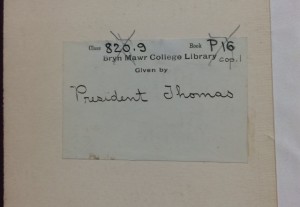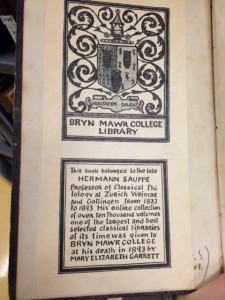My project began while I was making the Bryn Mawr history survey last month. I work at Carpenter Library and (until recently) Canaday, and I spent a lot of time looking at the books in the library collection. As you probably know, we have a lot of older books dating to the college’s founding and before, and many of these books have elaborate bookplates detailing the history of their donation. These books and their bookplates said a lot about the college’s history, and the types of things that have been memorialized.
My interest was especially sparked by the earliest books to enter the Bryn Mawr Collection, from the late 19th and early 20th centuries. Given the current campaign to rename Thomas Hall, I thought it was important to address the other ways that M. Carey Thomas is memorialized at Bryn Mawr and the many ways her legacy continues to shape the school. Although we may never open either of the two books I’m showing here (or the hundreds like them), her legacy is absolutely everywhere, from bookplates to the one above, books formerly in the Deanery library, to books like the one below that were procured by Mary Garrett. This school clearly needs to have a conversation about her and the oppression on which Bryn Mawr was built, and I want to make these books a part of that conversation.
These books and bookplates present a lot of complexities about campus memory and public history. They are in a strange place between public and private — closed within books that are exclusively accessible to people within the college community, but also meant to be handled by generations of students.
I wanted to focus on bringing them into the open, not just to show previously hidden aspects of our history but also complicate our relationships with objects that we take for granted.
As was obvious from last class, I care a lot about the materiality of objects and their historical importance, and I think these books have a lot of value because they reveal something about the way that power structures and painful histories (including M. Carey Thomas’s legacy of white supremacy) shape the types objects that we interact with everyday. None of this presents a solution, or even addresses what my project would be. Really I just want a space to have these types of conversations, and realize the ways that money and power impact things like book buying policies.
A few years ago Haverford did an exhibit about the early library collection (link) and I’m thinking along those lines, but I want something that will more directly address Thomas’s legacy and the founding of the college as it relates to books and the library.


